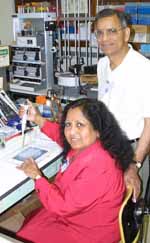Mathurs promote translational research
by Cindy AbolePublic Relations
Bridging the gap between basic science and clinical applications has been the focus of obstetrics and gynecology researchers Subbi and Rajesh Mathur.
Their efforts may result in improving cervical cancer detection and treatment among at-risk women and lay the groundwork to further understandings of other related cancers.
Last month, Subbi P. Mathur, Ph.D., was awarded an R21 Exploratory grant of $143,000 for two years from the National Cancer Institute to develop and study the potential markers of cervical cancer in women. Rajesh Mathur, Ph.D., a retired professor from the OB/GYN department since last October, will be her co-investigator on the project. The two-year modular grant award began April 1.
 OB/GYN's
Drs. Rajesh, left, and Subbi Mathur inside their research lab.
OB/GYN's
Drs. Rajesh, left, and Subbi Mathur inside their research lab.
The Mathurs' concept was founded in 1996 as the Department of OB/GYN shifted their scientific focus to promoting more translational research.
“We wanted to create a project that was clinically applicable in making a difference in patient care that conforms with the mission of the department and institution, while being fundable on a federal level,” said Roger C. Young, M.D., Ph.D., associate professor of benign gynecology, department of OB/GYN and clinical collaborator on the grant. “The Mathurs' project involves scientific research for cervical cancer ranging from pre-invasive to invasive cancer. The rate of cervical cancer cases in South Carolina is among the nation’s highest. We picked this because we felt that cervical cancer was a problem that we could justify as being important for the state.”
Each year, an estimated 14,500 new cases of cervical cancer are diagnosed in the U.S. Of these cases, close to 5,000 lives are lost to this deadly disease. In several third-world countries, cervical cancer is a major cause of mortality when left undetected.
What the Mathurs ultimately discovered were how certain growth factor markers could be used to detect the progression of a precancerous condition to cervical cancer. More specifically, they looked at protein levels of Epidemial Growth Factor Receptor (EGF-R) in the cervical epithelial cells and a serum and tissue Insulin-like Growth Factor II (IGF-II) in the patients with pre-invasive cervical intraepithelial neoplasia and cervical cancer and found them to be very high in cervical cancer patients. They are also extrapolating the study to identify pauci-cellular metastasis in the lymph nodes of these patients.
With their findings, they hope to develop a non-invasive blood test that measures IGF-II protein levels in at-risk cervical cancer patients to improve therapies and enhance outcomes. It is important to note that elevated IGF-I, but not IGF-II serum levels are found in breast, prostate and lung cancer patients, but not cervical cancer patients.
“A blood test will give patients more options and a confidence knowing that they may be disease-free just by monitoring their serum levels,” said Subbi Mathur, professor, department of OB/GYN and principal investigator of the grant.
The grant will allow them to coordinate expanded tests with at-risk women or cervical cancer study groups to determine the importance of a screening test for prediction and follow-up of therapy efficacy. Besides working with Young, the Mathurs will also collaborate with clinical gynecology specialists such as William Creasman, M.D., Matthew Kohler, M.D., Susan Tate, M.D. and other colleagues. Philip F. Rust, Ph.D., a professor emeritus from the department of Biometry, will act as their statistical consultant. They hope development of a serum marker test can be used as a companion to the Pap test and possibly serve as an effective screening test for cervical cancer and also help in assessing the efficacy of therapy.
“They’ve presented a novel approach to looking at the problem,” Young said. “A lot of researchers have shown something specific that can be seen as something cancerous. We’re very fortunate to find that one of the substances that is normally not present, but elevated in a patient with cervical cancer or dysplasia. Identifying these markers can be compared to observing stars against a dark sky at night, instead of looking against a lighted sky during the day.”
The award is a culmination of years of research work, collaboration and successful publication in several journals.
“What we have is a good example of a successful focused effort
in translational research,” Young said. “It represents a melding of skills:
immunocytochemistry, reproductive immunology, reproductive endocrinology
and molecular biology. Federal funding will allow us to integrate with
Hollings Cancer Center and other departments. It will help us extend basic
science research and allow for verification of ideas and theories.”